The Egypt I Knew: When Western Women Were Welcomed!
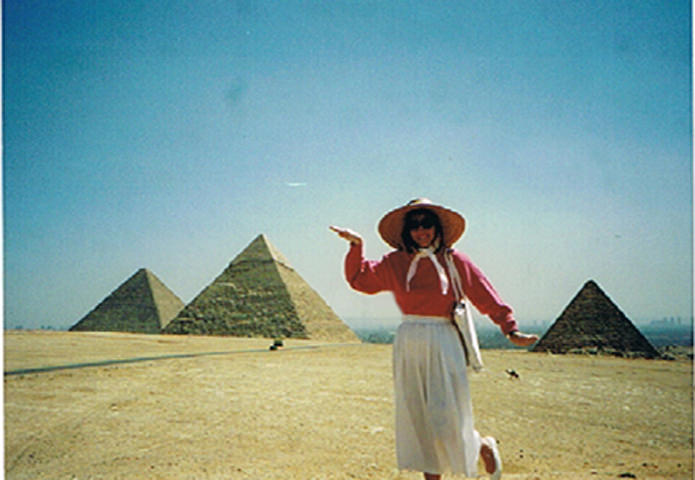
The Egypt I Knew: When Western Women Were Welcomed! By Patti Morrow.
The Egypt I Knew: When Western Women Were Welcomed!
By Patti Morrow
It was one of those milestone birthdays, over ten years ago. One of those times when you want to do something unique that will provide a lifetime of memories. Some call such places a “bucket list.” For a long time, Egypt had been at the top of mine. And so I took off from that runway in Boston, as excited as a school girl on her first date. Even my extensive research and wildest dreams would not adequately prepare for the sights I was about to see.
A Giza Kind of Birthday
Who hasn’t dreamed of the Giza pyramids, the only remaining of the Seven Ancient Wonders of the World? I had always imagined them to be secluded out in the middle of the Sahara Desert, but they lie just 15 miles southwest of the city. Viewing them on the horizon from some of the taller buildings was surreal.
The plan was to “climb” a pyramid on my birthday. My enthusiasm on arriving is apparent in the first photo taken. Wait! I can explain the outfit! Aside from the sunny, chilly April morning, I had been reading through Elizabeth Peter’s “Amanda Peabody” historical fiction serious based on the Victorian excavation of Egypt; I may have gotten a bit into character.
Approaching the Pyramid of Khufu, the oldest and largest of the three pyramids, I surreptitiously scrambled slightly up the rough underlying limestone (originally covered with smooth, white casing stones that have long worn away) to fulfill my birthday wish. But it was only after I walked around to Robbers Tunnel entrance that I learned there was another kind of climb – one that many of the other tourists declined: scaling the steep, narrow tunnel inside the pyramid.
4 feet x 3.5 feet, barely enough room for one person going up, and another coming down, I began my ascent up the constricted, 128 foot long passage. Once started, it’s impossible to turn back or even rest with someone at your heels, so the climb is not recommended for the claustrophobic. Hand-over-hand, I made my way straight up; the air was hot and humid, and about half-way up, the burning in my thighs and sore knees made me curse my insatiable thirst for adventure. Persevering, I was finally able to stand, stunned at the final destination – the Grand Gallery leading to the King’s Gallery, an ancient burial chamber with an empty stone sarcophagus thousands of years old. The feeling of getting a personal, insider’s look into what was the tallest, man-made structure until 1889 gave me a deep appreciation for this amazing accomplishment achieved without technology.
The passage down, feet first, was easier… but not much.
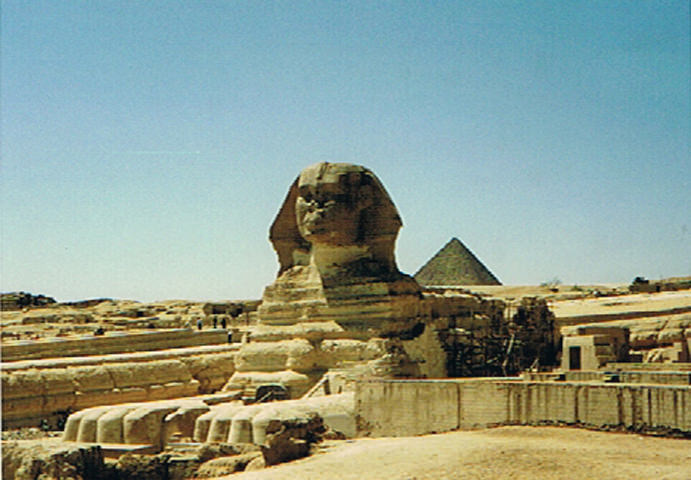
Sphinx Pyramid in Egypt
The massive limestone sculpture known as the Great Sphinx rests his paws quite close to the pyramids in the Giza necropolis. A pharaoh’s head (missing the nose and beard) on a lion’s body, this is the oldest monumental statue in the world. For much of history, the sculpture was buried in sand, except for the head. What a sight that must have been!
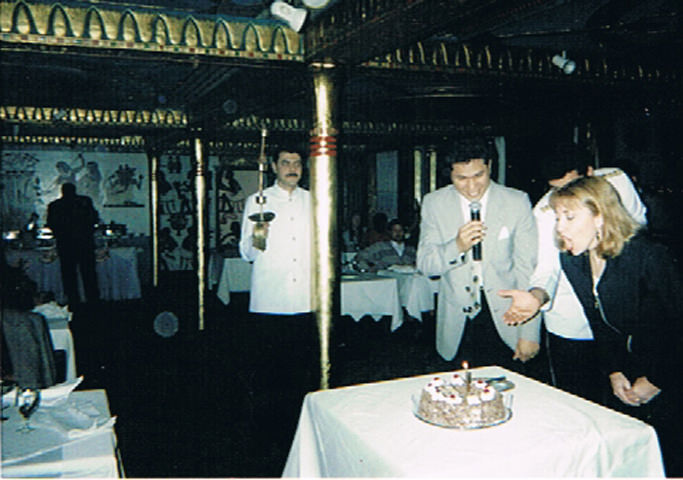
Patti Morrow celebrates her birthday on a luxury dinner cruise on the River Nile.
My birthday ended with a luxury dinner cruise on the Nile – several hours of drifting along enjoying decadent and traditional food, rambunctious belling-dancing and skirt-twirling entertainment, or just gazing at the lights along the banks of the Nile. There was an Egyptian wedding reception on the same ship, and when the captain brought out the cake, the entire wedding sang happy birthday to me, in Egyptian!
Chaotic, Crowed, Charismatic Cairo
Back in the city, I visited the Citadel – a medieval combination of fort, palace and mosque, with terraces offering grand views of the city.
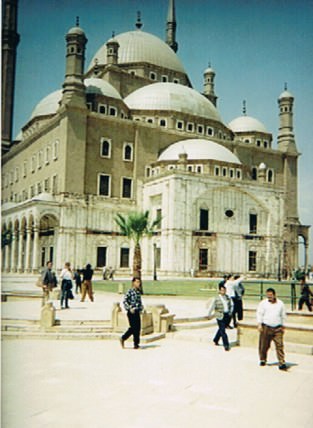
Patti Morrow explores the Cairo Citadel, a medieval Islamic fortification.
After that, the Egyptian Museum of Antiquities which contains some of the most stunning artifacts of human history such as the Mummy Room, gigantic statues, and the treasures of King Tut. At that time, some areas were stuffed with relics, and the cataloguing and placing seemed just a bit haphazard, which just added to the mystique of this already intriguing period of time.
No trip to Cairo would be complete without a visit to the souks – open-air bazaars enticing passersby with sound, smells, sights and just-for-you sales. Dating back to 1392, Khan el-Khalili is the largest and most popular. The shopkeepers are fiercely competitive, so it is not wise to even glance at an object or make eye contact if you’re not interested. I, however, was interested in much! And the merchants were all very attentive to one of the few light-haired women in the marketplace. Accustomed to this type of sale in many other countries, I enjoy the lively, friendly barter, which should result in a win-win scenario for both parties.
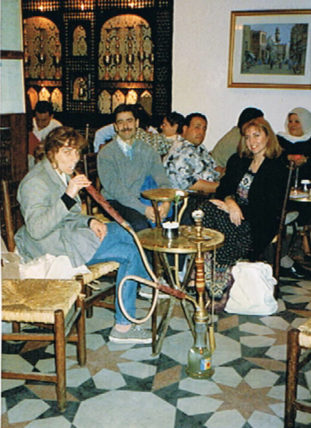
Visiting a Cairo coffee house.
Purchases made, a rest in one of the infamous coffee houses was in order, where my friend Cece tried some flavored tobacco smoked through one of the ever-present hookahs.
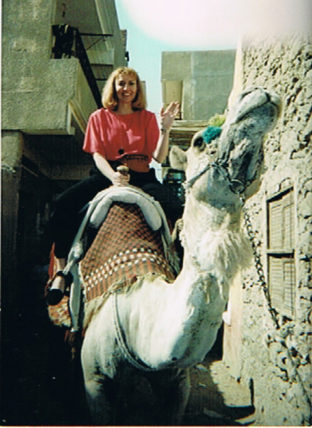
Patti Morrow rides a camel through the streets of Cairo, Egypt.
One of my most “gripping” Egyptian experiences was riding a camel though the streets of Cairo. Riding was a hoot, but getting off the creature was the stuff of nightmares. When the driver made the camel kneel on its front knees, I thought I was about to be hurled into space. But several Egyptian men caught me ever so gently…. and proceeded to escort me to their perfume shop next door! Welcome to Cairo! Some tourists really detest this aggressive solicitation. Me? Not a bit. I found the most delicate, sweet-smelling lotus oil. It’s long gone, and I’ve never been able to find anything remotely close to it in any other country.
I only had one negative experience in Cairo. Did I say “negative?” I meant to say frightening. Driving. In taxis. There were no lanes, no speed limits, no traffic lights. No regulations. It seemed like we were constantly on the verge of a head-on collision, with every driver on the road beeping his horn every two seconds. “I’m just saying hi to my friends,” our driver explained. I opted to simply close my eyes. Each and every time.
Exploring Ancient Thebes
A one-hour flight from Cairo landed me in another iconic locale: Luxor, Karnak, and the Valley of the Kings.
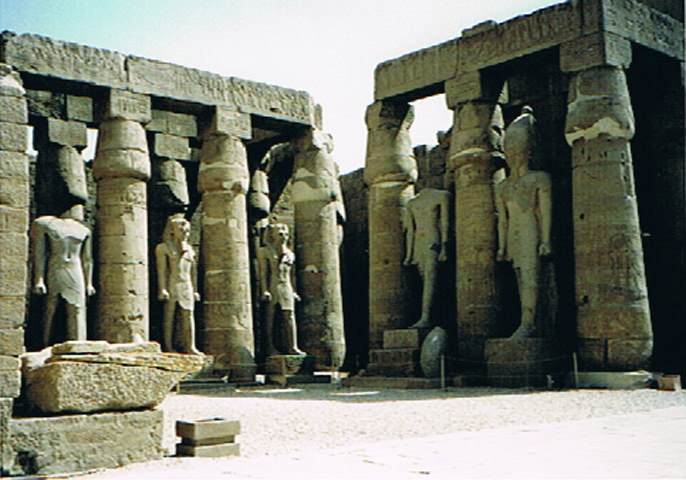
The Luxor Temple was founded around 1400 BC.
Luxor Temple, founded around 1400 BC, is just a short taxi drive away, on the east bank of the Nile River. We hooked up with an Egyptologist who had extraordinary knowledge of the history, construction and excavation of the temple. Highlights included mammoth obelisks, relief and hieroglyphics, statuary, and columned inner court.
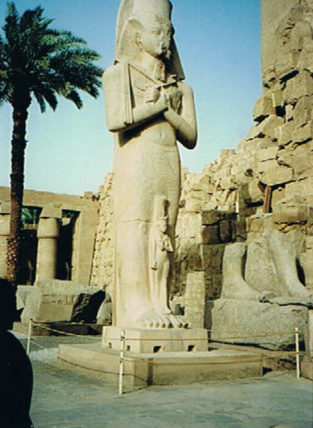
Karnak Temple is the largest open-air religious sight in the world.
Close by, on the same bank is Karnak Temple, the largest open-air religious sight in the world. What sets Karnak apart from other Egyptian sites is the length of time under construction, with contributions of approximately thirty pharaohs. While the atmosphere and appearance of the structures seems similar to Luxor, the sheer volume of Karnak is overwhelming. The Hypostyle Hall covering 50,000 sq ft with 134 massive columns is a highlight of this site.
Travel tip: When eating in one of the few outdoor eateries near the temples, stick to fresh vegetarian dishes, taboule and pita bread. My “hamburger” was definitely not beef – but that’s a story best left untold.
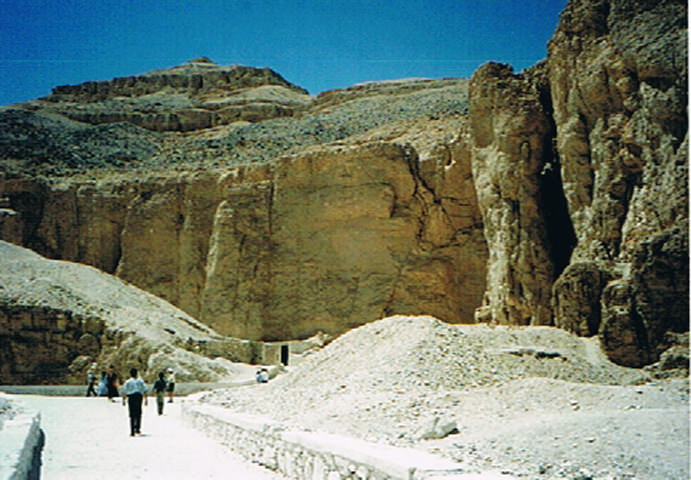
Two colossal statues of Amenhotep III stand as sentries to the burial place of the great pharaohs in the Valley of the Kings.
Across the Nile on the west bank is the Valley of the Kings where two colossal statues of Amenhotep III stand as sentries to the burial place of the great pharaohs. There were few people in the area and no tour guides in sight so we hired a taxi to drive us around. At first blush, it doesn’t look like much more than a valley between limestone cliffs. But within that bleak landscape are hidden entries cut into the rock leading to what were once magnificent caches of treasure, buried with rulers to accompany them in the afterlife. Although each tomb is now guarded, the treasures were discovered and removed by tomb raiders in antiquity; luckily the wall paintings of mythological scenes and hieroglyphics remain intact. The highlight is the tomb of Tutankhamen, the boy king, discovered in the 1920’s which was one of the few and last tombs still containing its treasures.
Adjacent is the lesser-known Valley of the Queens, a smaller U-shaped valley and burial place for royal wives and children. The most famous tomb of Queen Nefertari, royal wife of Ramses II, is considered to be the most beautifully painted tomb in Egypt. Unfortunately, the tomb is now closed to the public due to preservation concerns.
Our very late night flight back to Cairo was a white-knuckle affair through a sandstorm – I don’t recommend it.
As a light-haired American female, given the modern day volatility of region, terrorist assaults in the souks, embassy attacks and closings, and instability of the Egyptian government, I doubt I will feel safe returning to Egypt in the foreseeable future.
Some of the sites I visited are now closed to the public; others too dangerous to explore. I’m so glad I chose to check that most incredible destination off the bucket list while I had the chance.
Read More Travel Tips by Patti Morrow:
- Bora Bora: Bungalows, Beaches, Baguettes and Black Pearls
- Travel Tip: Curacao Ostrich Farm – This Place Is For The Birds!
- 10 Reasons to Visit La Paz, Mexico
BIO

Patti Morrow
Patti Morrow was born with incurable wanderlust, eventually leading her to a career as a freelance travel writer and photographer. She specializes in women’s adventure travel and has traveled throughout most of the United States and 35 countries abroad.
Patti has been published in numerous media, including International Living, Women’s Home Journal, Travel Post Monthly, MORE magazine, WAVEJourney.com, and Diva Toolbox and was featured on Tori Johnson (of Good Morning America) Spark and Hustle.
She is the editor of Luggage, Lipstick and Laptop, an online resource for women’s adventure travel, and is a member of ITWPA, AWAI, Intrepid Travel, Media Kitty, and TravelWriters.com.
See Where Patti Is Now:
http://www.luggageandlipstick.com/
https://www.facebook.com/pattimorrowI
https://twitter.com/vagabondPatti





















Pingback: Baby Boomer Travel Trends
Pingback: Places to Visit in Egypt...When Western Women Were Welcomed